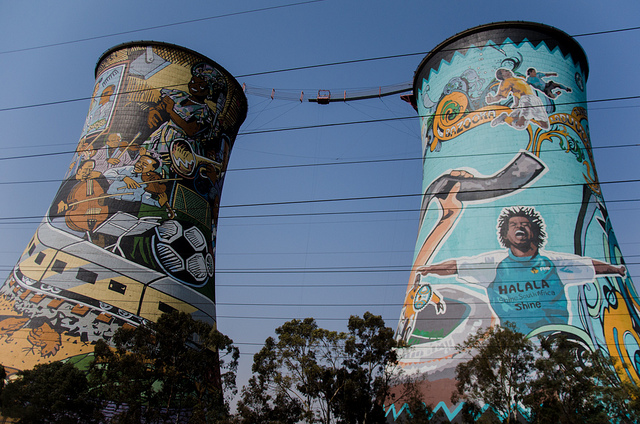Soweto, an acronym for South-Western Township, is a culturally rich area on the southwestern periphery of Johannesburg that is home to 40% of the city’s population. Once dismal and depressed, Soweto is now a bustling destination in its own right with many important landmarks, historical sites, and cultural opportunities –and it is THE place to go to in order to really learn about apartheid. Here are 10 things to do in Soweto.
1. Hector Pieterson Museum & Memorial
The Orlando West section of Soweto was the scene of violent protests in 1976, when students faced off against police over the apartheid government’s plans to make instruction in Afrikaans mandatory. Hundreds were killed, including 13-year-old Hector Pietersen, who was captured in the iconic photograph above. The museum named after him, which opened in 2002, offers a collection of oral testimonies, pictures, audiovisual displays and historical documents relating to the Soweto uprisings.
2. Nelson Mandela House
Also in Orlando West is the house where Nelson Mandela (and various family members) lived off and on from 1946 to the 1990s. Located on the corner of Vilakazi and Ngakane streets, it houses various memorabilia, arts and crafts, honorary doctorates conferred on Mandela, and picture collections of the Mandela family. Cost: South African adults: R40; Foreign adults: R60.
3. Orlando Towers
These iconic mural-covered towers were once part of a coal-fired power station, but have long since been decommissioned. Now they are a popular photo opportunity, and also home to bungee jumping, abseiling, zip lining, pendulum swinging, paintball and Chaf Pozi, a shisanyama (township braai) restaurant.
4. Walter Sisulu Square
Those interested in South African history should head to Kliptown, one of Soweto’s oldest neighborhoods, and visit Walter Sisulu Square. The striking circular Freedom Charter monument contains the 10 clauses agreed to in 1955 by Sisulu and others dedicated to the struggle to end apartheid. The square functions as a open-air museum, with various other pieces of memorabilia and art works. There is also a shisa nyama, market stalls, a hotel and a convention centre.
5. Diepkloof Park
This interesting little park is called an “Xtreme Park,” because it was built in just 24 hours out of a dusty, litter-filled, blighted area. Now it is a community meeting point with a multi-purpose sports court, a giant TV screen, a soccer field, playground equipment, picnic and braai areas, bathrooms, fountains and “expression” walls (where residents can write whatever is on their minds).
6. FNB Stadium
Also known as “Soccer City” and “the calabash,” this 94,000-seat stadium at the edge of Soweto is the home of the Kaizer Chiefs soccer team, and was the site of many soccer World Cup 2010 events. Rugby is also played there. It has political significance too: It’s the place where Nelson Mandela was welcomed back to Soweto after his release from prison in 1990, and where he was eulogized after he died in 2013. Now you can go see a soccer match, a concert, or take a behind-the-scenes tour.
7. Regina Mundi Church
The largest Roman Catholic church in south Africa, Regina Mundi is notable for its activism during apartheid, when it opened its doors to anti-apartheid groups and provided shelter to activists. After the end of apartheid, it was the place where Archbishop Desmond Tutu presided over the Truth and Reconciliation Commission hearings.
8. Credo Mutwa Cultural Village
This unusual attraction is a collection of sculptures and structures created by African artist and traditional healer Credo Mutwa between 1974 to 1986. The pieces combine African folk art styles with themes that explore the increasing Westernisation of African society. Renovation of the site is ongoing since it was resurrected in 2006, so don’t expect a pristine museum-like display; but don’t miss it for that reason — it’s a fascinating cultural experience.
9. Eat and drink!!
Jazz Maniacs, Choc’s Restaurant & Bar, Nambitha’s Restaurant, Roots Restaurant & Gallery, Sakhumzi Restaurant, uBuntu Kraal Brewery, and Wandies Place are just some of the many places to indulge in traditional South African food (and beer). If you’re in town in early September, there’s also the Soweto Wine Festival, which celebrates its 11th year in 2015.
10. Take a tour
Numerous companies can show you around Soweto, either by bus, bike, or on foot. City Sightseeing offers a Soweto extension to its hop-on-hop-off Johannesburg tour, while Soweto Bicycle Tours and Cycle in Soweto can take you around on two wheels. You’ll cover less ground but also get good exercise on a walking tour, which can be done through an outfitter like the excellent Past Experiences. Local guides portray the area positively but realistically, and provide context and commentary on what you’re seeing.
Want to discover the finer side of Africa? Sign up for our weekly newsletter.


